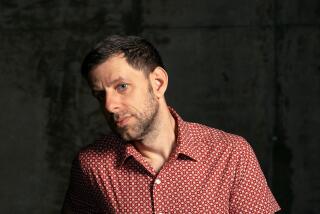Review: Industry’s remarkable ‘Crescent City’ reshapes L.A. opera
- Share via
At the world premiere Thursday night of Anne LeBaron’s darkly mysterious, troubling yet weirdly exuberant and wonderfully performed new opera “Crescent City,” a young Reveler in the production frolicked a few feet from where I was sitting on a folding chair along the perimeter of the experimental art space, Atwater Crossing. She wore a skirt fashioned out of the Arts & Books section of this newspaper, and she was close enough that I could read a few crumpled lines.
But she was hardly there to make me or any other Angeleno feel remotely at home. Distortion seemed more her determination.
Crescent City is a kind of Katrina-soaked, voodoo-infested, apocalyptic New Orleans, where mystical forces can really mess things up. And “Crescent City” is billed as “hyperopera,” meaning that it includes the contributions from a wide range of artists (meta-collaboration is the fashionable term), each of whom has his or her way of really messing reality up. Hyper-reality?
Where to begin? That is an audience member’s first of many alluring challenges for taking in “Crescent City.” LeBaron’s opera is the first project of an industrious, and potentially groundbreaking, new enterprise called The Industry that was founded by Yuval Sharon, a young director with his fingers in many of L.A.’s different and distinctive art pies. He sees hyperopera, he writes in a program note, as “a see-sawing state between multiple possible meanings.” And he does mean seesaw.
The point is that perspective never is, in opera with its many different elements, fixed, so why pretend otherwise? The list of credits for “Crescent City” is so long that to name them all and describe what they have done would more than use up the word count for several newspaper reviews. Sharon invited six emerging L.A. visual artists — Mason Cooley, Brianna Gorton, Katie Grinnan, Alice Könitz, Jeff Kopp and Olga Koumoundouros — to design a set of art installations of, respectively, shack, cemetery, junk heap, swamp, hospital and dive bar for a warehouse-like space.
The audience has, at different prices, different choices of where to be. One can choose to stand and move around on a promenade behind the perimeter seats. Bean bag cushions in the dive bar on stage are another option, as are seats overlooking the stage from on high.
There is, from wherever you are, a lot to look at. The art, of course. Ivy Y. Chou’s quirky costumes, some silly, some not. Large screens on the walls offer artfully fuzzy video (the Revelers do some of the camera work) of action you might miss, depending upon where you sit or stand.
But at the end of the operatic day, “Crescent City” is still an opera. LeBaron’s fantastical layering of musical styles and robust vocal writing, Douglas Kearney’s poetically rich libretto, a great cast and Sharon’s compelling direction are what makes “Crescent City” matter.
The creepy story concerns a resurrected voodoo queen who steps out of her grave to survey the flood and summon voodoo gods (the Loa) for assistance. They’re a supercilious bunch and will only agree to save the city if a good man can be found. One is and he loses his mind. The characters include a cop haunted by Samedi (one of the Loa), the cop’s sidekick and a couple of kinky nurses. A drag queen, Deadly Belle, provides a delicious Brechtian cynical summing up of the ensuing chaos. Salvation remains an open question.
LeBaron’s score includes a complex of styles. There is the Cajun and Creole music, the jazz and zydeco from her native New Orleans, which LeBaron layers to create atmosphere. She is fluent in grandly operatic manner and in the language of avant-garde. A lot can happen at once, or she can focus very simply on the moment. This too is a perspective that is always changing, and always captivating.
Sharing the stage with the singers is more than worth the very reasonable price of admission alone. Gwendolyn Brown, a deep contralto, made Marie a transfixing force of nature. Bass-baritone Cedric Berry’s intense characterization of the Good Man brilliantly encapsulated the destructive rage that results from injustice. Tenor-and-then-some Timur Bekbosunov was a riot as Deadly Belle, with his stratospheric voice and his stratospheric platform shoes. But his is that rare over-the-topness that conveys authentic emotion. Jonathan Mack (Cop), Ashley Faatoalia (Jesse), Lillian Sengpiehl (Homesick Woman) and the others were all outstanding.
The orchestra, hidden away (at least from where I was sitting), was conducted by Marc Lowenstein and it was a combination of a traditional chamber orchestra and a postmodern cabaret band.
But the sound design from where I sat was a problem. This is no doubt a hard space in which to work out amplification.
But it’s an inviting space with an excellent cafe. The Industry deserves a very big cheer. We now have something that can genuinely be called L.A. opera.
RELATED:
An edgy opera company gives it a go in Los Angeles
Review: Gustavo Dudamel, L.A. Philharmonic feast on Mozart
Music review: San Francisco Symphony’s John Cage ‘Song Books’
More to Read
The biggest entertainment stories
Get our big stories about Hollywood, film, television, music, arts, culture and more right in your inbox as soon as they publish.
You may occasionally receive promotional content from the Los Angeles Times.











